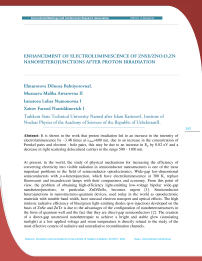Enhancement of electroluminescence of ZnSe/ZnO:O, Zn nanoh heterojunctions after proton irradiation
Автор: Elmurotova D.B., Mussaeva M.A., Ismatova L.N., Xaitov F.N.
Журнал: Science, Education and Innovations in the Context of Modern Problems @imcra
Статья в выпуске: 2 vol.4, 2021 года.
Бесплатный доступ
It is shown in the work that proton irradiation led to an increase in the intensity of electroluminescence by ~3.48 times at λmax=600 nm, due to an increase in the concentration of Frenkel pairs and electron - hole pairs, this may be due to an increase in Eg by 0.02 eV and a decrease in light scattering delocalized carriers in the range 500 - 1100 nm.
Короткий адрес: https://sciup.org/16010099
IDR: 16010099
Текст научной статьи Enhancement of electroluminescence of ZnSe/ZnO:O, Zn nanoh heterojunctions after proton irradiation
At present, in the world, the study of physical mechanisms for increasing the efficiency of converting electricity into visible radiation in semiconductor nanostructures is one of the most important problems in the field of semiconductor optoelectronics. Wide-gap low-dimensional semiconductors with p-n -heterojunction, which have electroluminescence at 300 K, replace fluorescent and incandescent lamps with their compactness and economy. From this point of view, the problem of obtaining high-efficiency light-emitting low-voltage bipolar wide-gap nanoheterojunctions, in particular, ZnO/ZnSe, becomes urgent [1]. Semiconductor heterojunctions in nanostructures-quantum devices, used today in the world as optoelectronic materials with tunable band width, have unusual electron transport and optical effects. The high intrinsic radiative efficiency of blue/green light-emitting diodes (p-n-injection) developed on the basis of ZnSe and ZnTe is due to the advantages of the configuration of nanoheterostructures in the form of quantum well and the fact that they are direct-gap semiconductors [2]. The creation of a direct-gap unstressed nanoheteropair to achieve a bright and stable glow (simulating sunlight) at a low applied voltage and room temperature is directly related to the study of the most effective centers of radiative and nonradiative recombination channels.
Science, Education and Innovations in the context of modern problems, 05 NOV, 2021 Baku, International Conference
The aim of the study is to determine the energy and population of the levels of the electronic structure from optical absorption and electroluminescence of ZnSe/ZnO:Zn nanoheterojunctions.
The object of research: scintillator crystals ZnSe:O,Zn, which were grown by the Bridgman method at the Research Institute of Monocrystals (Kharkov, Ukraine) [3]. To create additional V Zn , the samples were doped with O, and treated in Zn vapor to obtain p-type conductivity and reduce nonradiative surface recombination. The polished plates had a thickness of 1 to 5 mm and an area of 12 cm2.
Research methods: Optical absorption (OD) spectra were measured on a modern SF-56 spectrophotometer (LOMO) at 300 K in the wavelength range 190-1100 nm and optical densities D=lg(I0/I) up to 5 (in contrast to 2-beam devices with limited D=2.7). The instrument error is ± 5%. The tables show the optical densities at the maxima of the absorption bands and the corresponding transition energies. The concentration of optical centers N (cm-3) responsible for the isolated absorption band was calculated using the Smakula formula where n - is the refractive index for the wavelength corresponding to the maximum of the absorption band, in the case of the Eg band for the ZnSe crystal, n=2.6645; the f-force of the oscillator for transitions involving the band is equal to 1; H-band half-width, (eV); Km - is the absorption coefficient at the maximum of the band (cm-1), which depends on the optical density (OD) - D and the thickness l (cm) as Km=D/l. -concentration of electrons at the Eg level. It depends on the error in determining the half-width and other experimental values. The OD spectra of wide-gap semiconductors provide information on the width Eg, the presence and degree of population of donor, acceptor, impurity, and exciton levels. From the level and nature Page 163 of absorption in Еg one can judge about the scattering of electromagnetic radiation by free carriers and plasma reflection at l The Electroluminescence (EL) and Volt-radiance dependence (VRD) spectra were measured on a spectral instrument-monochromator SPM-2, in the wavelength range of 200-900 nm at 300 K. First, a low voltage of both polarities was applied, the EL spectrum was recorded, and the maximum of the band was determined. The accuracy of determining the wavelength was ± 5%, the error in determining the intensity did not exceed ± 10%. The threshold voltage was determined at the onset of the EL appearance (the glow was visually observed starting from 5 V), then the operating voltage was selected with an accuracy of ± 5%, Volts, according to the EL stability. If, during the measurement, the voltage is increased after reaching the maximum EL amplitude, the conditions for maintaining avalanche multiplication in the barriers are violated, which leads to the breakdown of EL and the destruction of radiative recombination centers. The EL excitation voltage corresponds to the height of the potential transition barrier, and the wavelength determines the energy of the radiative transition and the position of the level. Optical density spectra of NGJ ZnSe/ZnO:O,Zn after proton irradiation: Fig. 1 Spectra of the OD NGJ ZnSe/ZnO:O,Zn before (1) and after (2) irradiation with protons Science, Education and Innovations in the context of modern problems, 05 NOV, 2021 Baku, International Conference Theoretical data showed that in a wide-gap single crystal ZnSe, which has Еg=2.7 eV, resonance levels (RL) are created in the conduction band. These RL were experimentally observed by measuring optical absorption (OD) spectra and calculated Ne at each generated level before and after proton irradiation. Tab. 1 Energies (eV) and OD (D) levels and calculations of Ne in NGJ ZnSe/ZnO:O,Zn before and after irradiation with protons Here, we present the results of experimental studies of the spectra of the OD NGJ ZnSe/ZnO:O,Zn before and after proton irradiation, as well as calculations of the electron concentration (Ne) according to the Smakula formula. Theoretical studies have shown that in a wide-gap ZnSe single crystal with Eg=2.7 eV, RL are created in the conduction band, taking into account the temperature in the sequence А1,3с, Г6v, L1,3, М4V etc., where the direct-gap transition is at the G-point. The exciton PL of ZnO was observed in the form of a narrow band near λmax=383 nm (3.23 eV), which appears either upon recombination of interacting free excitons or upon recombination of e-h plasma [4]. It was also shown that the PL spectrum of n-ZnSe crystals annealed in vacuum and in Zn vapor had two narrow bands A (443 nm, 2.799 eV) and B (458 nm, 2.707 eV) [5]. In fig. 1 shows the spectra of OD D(l) NGJ ZnSe/ZnO:O,Zn (B) before (curve 1) and after proton irradiation (curve 2). All obtained curves are reproducible with an error of Dl=1 nm. It can be seen that RL Г6v and L1.3v, were formed in the ZnSe/ZnO:O,Zn NGJ, which, after irradiation with protons, are destroyed, where this led to a shift of Eg by 0.02 eV. It can be seen from the table that the ZnSe/ZnO:O,Zn NGJ with formed RL had Ne=4.83×1016 cm-3, but irradiation with protons by the destruction of these RL led to 13-fold decrease in Ne, which may be due to the dissolution of a ZnO nanoparticle from the ZnSe surface. According to the literature, it is known that wide-gap ZnSe(Te):Zn crystals have thermo luminescence, photoluminescence, gamma-luminescence, X-ray luminescence at the maxima of 580 nm, 600 nm, 620 nm, etc., which creates a level in the band gap. The surface ZnO layer plays the role of an injecting contact to the p-ZnSe layer, and also serves as a "window" for radiation output. In [6], it was shown that when exposed to a high-power pulsed laser, the number of bands in the ZnSe PhC spectrum depends on the n-concentration of the impurity, where, with an increase in n to 1016 cm-3, Eg increases from 2.670 to 2.557 eV. In our case, Eg shifts from 258 to 2.6 eV. Irradiation in ZnSe/ZnO:O,Zn caused a decrease in light scattering by delocalized carriers in the region of 500-1100 nm (band gap), which is consistent with the observed decrease in resistance. The following are the spectra of the Volt-radiance dependence (VRD), EL NGJ before and after irradiation with protons. Figure 3 – Electroluminescence spectra of ZnSe/ZnO:O,Zn heterostructures treated in zinc vapor: 1 – non-irradiated, 2 - after proton -irradiated to the dose of 1015 сm-2. (a) at the reciprocal (reverse) and (b) at the direct polarity of the voltage Science, Education and Innovations in the context of modern problems, 05 NOV, 2021 Baku, International Conference Figure 2 Volt-radiance dependence of electroluminescence at the band of ~ 600 nm of the ZnSe/ZnO:O,Zn nanoheterostructures treated in zinc vapor: 1 non-irradiated, 2 - after protonirradiation to the dose of 1015 сm-2. (a) at the reciprocal (reverse) and (b) at the direct polarity of the indicated voltage values. In fig. 2 and 3 shows the VRD of the EL NGJ ZnSe/ZnO:O,Zn before (1) and after (2) the effect of proton irradiation with a fluence of 1015 cm-2. Experiments have shown that the initial samples had EL when applied U>20 V, while the samples were very hot, which led to the degradation of the electrodes. According to [7] ZnSe-Ni single crystals with a high-resistance ZnO layer had a pre-breakdown EL with a breakdown voltage UV≈31 V, in the form of a set of luminous points randomly located over the entire area of the rectifying contact, as in our case for ZnSe/ZnO:O,Z NGJ. The PL spectrum of ZnO:N had λmax~410 and 590 nm. In ZnSe, the absorption band at ~500 nm (~2.48 eV) is associated with defect centers, including (double-charged Zn vacancy) - , self-activated radiation of the donor center ~ 620 nm (~ 2.01 eV), and isolated VZn~720 nm (~ 1.72 eV) [3]. According to in pure ZnSe self-activated luminescence is observed in the 590 nm band. In [8] yellow luminescence in n-ZnO/p-GaN/n-GaN/Al2O3 heterostructures appears under the ZnO contact, which becomes white with increasing current and then violet-white. It was shown that proton irradiation led to an increase in the EL intensity (IEL) and to a decrease in the threshold EL voltage, which may be due to an increase in Eg by 0.02 eV. Consequently, an increase in EL can be explained by an increase in the nonequilibrium concentration of Frenkel pairs and e-p pairs, some of which were localized at defects such as Zni and ZnO precipitates. The dependence of IEL on voltage is exponential. When investigating the VRD, Umax was chosen, at which the most intense EL is observed for the images in Fig. 3 (right). With the reverse polarity IEL of the initial sample reached 11.5 at Umax=-32 V, and with the forward polarity 36.25 at Umax=27 V, where, after irradiation with protons, it increases by ~ 3.48 times at Umax=-24 V, the direct polarity by ~1.46 times at Umax=15 V. In the EL spectrum, as can be seen, a broad maximum ~600 nm is found, since the observed spectra, which are due to Page 165the nonuniform distribution of O and Zn impurities over the sample volume, are strongly depend on the polarity of the applied voltage, the observed broad maximum can consist of several bands, which include the 590 nm band. Our results are consistent with [3], where the CL spectrum was represented by "self-activated" emission at λ=600 nm of a bound D-A pair at 300-400 K. The same band was observed in ZnSe:Zn (n>1019 cm-3). Self-activated PL lmax=600 nm at deep acceptor centers was observed in n-ZnSe single crystals annealed in a LiCl melt and doped with Cu, Ag, Au. The PL band 450550 nm of nanosized ZnO-structures is attributed to the recombination radiation of e-h pairs. In the PL spectrum shows that treaded of ZnSe single crystals in Zn vapors led to the formation of (VZn+D++TeSe) associates based on Frenkel defect pairs responsible for the self-activated PL bands lmax=1.99 and 2.07 eV at 300 K. Also shows an increase in the solubility of O in crystals ZnSe:Cu,O with an excess of Zn. Conclusions: After irradiation with protons, irrespective of the polarity in the ZnSe/ZnO:O,Zn NGJ, IEL, respectively, and Eg also increased by 0.02 eV, which is associated with a decrease in light scattering by delocalized carriers in the range of 500-1100 nm and an increase in the concentration of Frenkel pairs and e-p pairs.



